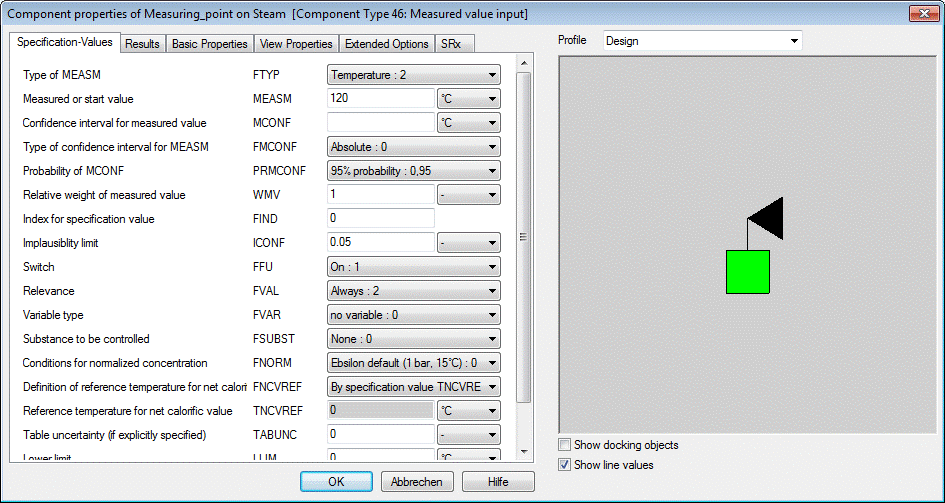

The measurement value parameters are entered in the properties sheet of the component measurement point (component 46). This can be opened by double-clicking a measurement point in the Ebsilon model.

The measurement values are entered here manually under MEASM. This can be extremely useful for the layout of the model. In running operation, however, the measured values are entered via an interface (Excel, EPOS system).
When doing a validation as per VDI 2048, the confidence intervals of the measurement points must be specified under MCONF. This is the deviation of the measured value from the true value, which will not be exceeded with a probability of 95%. This information must be known or must be estimated correctly.
MCONF need not be entered in case of an Ebsilon quick validation. Instead, the relative weight of the measurement point is to be entered under WMV. This has a value of 1 by default. (absolute values are to be entered with error calculation for the result values).
The parameter FIND is relevant only for Specification Value Validation.
The quantity ICONF (relative confidence interval) helps in checking the plausibility of the measurement point. In the Ebsilon quick validation, ICONF decides, whether a measurement point is identified as doubtful in the validation report (if the measurement value deviates from the calculated value by more than ICONF). When doing a validation according to the guideline VDI 2048 sheet1, the relation 141 specified there is evaluated (value in the measured value screen stored in RELDEV) and is marked when the upper limit of 1.96 is exceeded. If the measured value still lies below this limit, but the relative deviation is greater than the ICONF-band width (alarm limit specified by the user, which has no reference to VDI 2048 hat), the status is also set to warning.
Along with the method recommended in the guideline VDI 2048 sheet 2 section 7.7.2 for the spread of the inappropriately narrow standard deviations, in Ebsilon during the iterative validation calculation, those measurement values are automatically set to invalid, which exceed the double value of ICONF. This is shown in the validation list. This is an immediate reason for an error analysis.
This method helps to prevent a falsification of the total result by completely false measurement values or by invalid confidence intervals. A too small confidence interval of a very faulty measurement value would cause a wrong shift of the other validated values, or else a measurement value, which is off the mark by a factor of 1000 owing to a wrongly entered unit, pulls the other measured values also in the wrong direction by minimizing the mean error square. In case of periodic calculations within the online power plant monitoring, this method is used, however with colour identification in the control room.